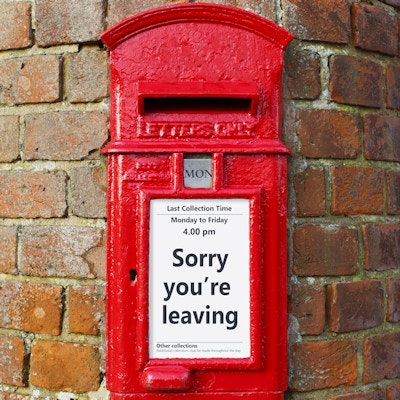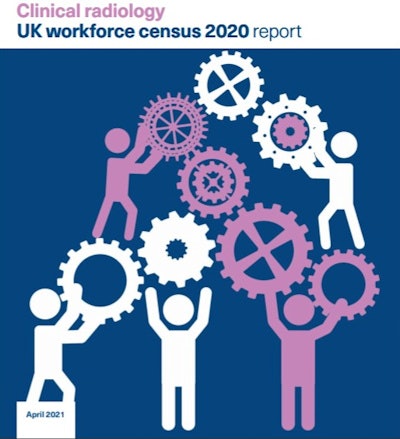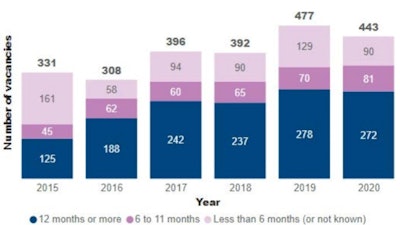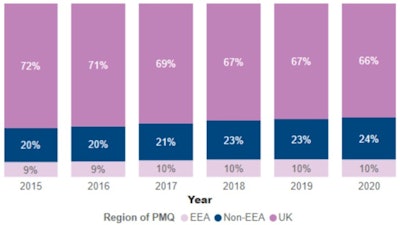
Fears are growing that large numbers of U.K. doctors will leave the National Health Service (NHS) over the coming months, but there is no evidence yet that radiology is suffering a mass exodus, the Royal College of Radiologists (RCR) has reported.
Over the past year, 134 clinical consultant radiologists have left the U.K. workforce, which is equal to a 4% rate of attrition, according to an annual census published on 28 April by the RCR.
"This is on a par with the 4% average U.K. attrition rate seen over the past five years. It is a positive finding that attrition rates did not rise in 2020, given the significant workforce pressures including the COVID-19 pandemic and widespread radiology workforce shortages," noted the authors of the 70-page document, "Clinical radiology UK workforce census 2020 report."

Over the past five years, annual attrition has been higher in Scotland (5% average) and lower in Northern Ireland (2% average), compared with the U.K. average (4%). The median U.K. retirement age for radiologists has remained steady at 60 years; the average retirement age for full-time consultants is 59 years, compared with 62 years for part-time consultants, the RCR stated.
Disillusioned staff
However, thousands of U.K. doctors are planning to quit the NHS after the COVID-19 pandemic because they are exhausted by their workloads and worried about their mental health, according to an article posted on 3 May by the Guardian.
Long hours, high demand for care, the impact of the pandemic, and unpleasant working environments are taking their toll on medics, the story noted.
In a survey of 5,521 doctors conducted by British Medical Association, 1,352 (32%) of the 4,258 who replied to a question about whether their career plans had changed over the last 12 months said they were now more likely to retire early than they were last year -- more than double the 14% who said the same in June 2020.
Smaller proportions were more likely to take a career break (25%), leave the NHS for an alternative career (21%), work in another country (17%), or become a locum (15%). Some respondents selected more than one option. In addition, half said they were more likely to reduce their hours, the Guardian reported.
"It's deeply worrying that more and more doctors are considering leaving the NHS because of the pressures of the pandemic -- talented, experienced professionals who the NHS needs more than ever to pull this country out of a once-in-a-generation health crisis," said Dr. Chaand Nagpaul, the leader of the British Medical Association.
Vacancies for radiologists
U.K. radiology clinical directors reported 443 vacancies in 2020, according to the RCR census. This primarily comprised consultant-grade vacancies (n = 422), though four specialty and associate staff (SAS)-grade doctors and six research/clinical fellow vacancies were also available.
"Vacancy data provide insight into the extent of workforce shortfalls. However, they do not reflect the entire shortfall as vacancies are constrained by budgets, a lack of suitable candidates and other factors," the authors wrote.
Three-quarters of NHS trusts/hospital groups and health boards reported having at least one vacancy in September 2020, and the vacancy rate for consultant radiologists was 10%. The consultant vacancy rate is highest in Scotland at 12% and lowest in Northern Ireland at 8%.
 The five-year trend in the number and length of radiologist vacancies in the U.K.
The five-year trend in the number and length of radiologist vacancies in the U.K.Vacancies for consultant and SAS-grade radiologists are increasingly challenging to fill, the RCR pointed out. This is highlighted by the growing proportion of vacancies that remain unfilled for over a year despite numerous recruitment attempts. In 2020, nearly two-thirds (62%) of consultant vacancies remained unfilled after a year, compared with 38% in 2015.
Global recruitment drive
Over the past five years, radiology departments have increasingly turned to global recruitment to fill vacancies due to insufficient supply within the U.K. Fuelled by recruitment from non-European Economic Area (EEA) countries -- notably India, Pakistan, and Egypt -- the radiology workforce has gradually become more international, according to the RCR.
 Clinical radiology consultants' region of primary medical qualification (PMQ, a proxy for nationality)
Clinical radiology consultants' region of primary medical qualification (PMQ, a proxy for nationality)The non-EEA proportion of the U.K. clinical radiology consultant workforce has steadily grown from 20% to 24% over the past five years. EEA recruitment has not increased at the same pace in recent years; CR consultants from the EEA comprise 10% of the clinical radiology workforce, compared with 9% five years ago.
For full details about the census and to download a free copy, go to the RCR website.



















